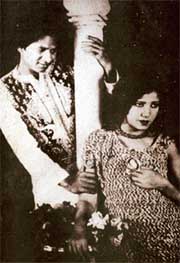Related Research Articles

Sambhaji, also known as Shambhuraje, was the second Chhatrapati of the Maratha Empire, ruling from 1681 to 1689. He was the eldest son of Shivaji, the founder of the Maratha Kingdom. Sambhaji's rule was largely shaped by the ongoing wars between the Marathas and the Mughal Empire, as well as other neighbouring powers such as the Abyssinians of Janjira, Wadiyars of Mysore and the Portuguese Empire in Goa. After Sambhaji's execution by Aurangzeb, his brother Rajaram I succeeded him as the next Chhatrapati and continued the Mughal–Maratha Wars.

Chhatrapati is a royal title from Sanskrit used to denote a king. The word "Chhatrapati" is a Sanskrit language compound word of chhatra and pati (master/lord/ruler). This title was used by the House of Bhonsle, between 1674 and 1818, as the heads of state of the Maratha Confederacy.

Shahu I was the fifth Chhatrapati of the Maratha Confederacy founded by his grandfather, Shivaji I. He was born into the Bhonsle family, and was the son of Sambhaji I and Yesubai. At a young age, he was taken into custody at the Siege of Raigad by Mughal emperor Aurangzeb, and held captive. He was released from captivity after the death of Aurangzeb in the hope of engineering an internecine struggle among the Maratha factions of Tarabai and Shahu. Shahu emerged victorious in the bloody Battle of Khed and was crowned as Chhatrapati.

Rajaram Bhonsle I was the third Chhatrapati of the Maratha Kingdom, who ruled from 1689 to his death in 1700. He was the second son of the Shivaji, the founder of the empire and younger half-brother of Sambhaji, whom he succeeded. His eleven-year reign was marked with a constant struggle against the Mughals. He was succeeded by his infant son Shivaji II under the regentship of his dowager Maharani Tarabai.

Maharani Tarabai Bhosale (née Mohite) was the regent of the Maratha Empire from 1700 until 1708. She was the queen of Rajaram I, and daughter-in-law of the kingdom'd founder Shivaji I. She is acclaimed for her role in keeping alive the resistance against Mughal rule in Konkan, and acting as the regent during the minority of her son, Shivaji II and defeated Aurangazeb
Hambirrao Mohite (1630–1687), also known as Hansaji, was a prominent Maratha general who held the esteemed position of the 5th Senapati of the Maratha Army during the reign of Chhatrapati Shivaji. He was recognized for his exceptional military prowess and successfully led various campaigns on behalf of Shivaji, subsequently continuing his service under Chhatrapati Sambhaji.
Murud is a town and a municipal council in Raigad district in the Indian state of Maharashtra. Situated at a distance of 150 km (93 mi) from Mumbai, Murud is a tourist destination. The Palace of Nawab is located in Murud. The palace was built in 1885 for administration purposes. The palace is still owned by the descendants of the Nawab and is a private property.
Sangameshwar Taluka is a taluka in Ratnagiri subdivision of Ratnagiri district in the Indian state of Maharashtra. The headquarters for the taluka is the town of Devrukh. In Sangameshwar the two rivers Sonavi and Shastri flow together. The meaning of Sangama in Marathi is "confluence," and so the name "Sangameshwar". It is historically important as the place where Chhatrapati Sambhaji, son of Chhatrapati Shivaji was captured by Mughal Emperor Aurangzeb. Chhatrapati Sambhaji was tortured and executed in Tulapur.

Saibai Bhosale was the first wife and chief consort of Chattrapati Shivaji, the founder of the Maratha Empire. She was the mother of her husband's successor Chattrapati Sambhaji.

Master Vithal or Vithal (1906-1969) was an actor in Indian cinema, best known as the hero of India's first talkie Alam Ara (1931) and of Marathi and Hindi silent stunt films, which gave him the epithet as the Douglas Fairbanks of India.

The Maratha Navy was the naval wing of the armed forces of the Maratha Empire, which existed from around the mid-17th century to the mid-18th century in the Indian subcontinent.
Gopal Balwant Kamble was an Indian painter known for painting Bollywood movie posters and realist portraits of people from Maharashtra.

Yeu Kashi Tashi Me Nandayla is an Indian Marathi language television series which aired on Zee Marathi. It starred Anvita Phaltankar and Shalva Kinjavadekar, with Shubhangi Gokhale, Nikhil Raut, Aditi Sarangdhar in supporting roles. It premiered from 4 January 2021 by replacing Tujhyat Jeev Rangala. It is produced by Tejendra Neswankar under the banner of Trrump Carrd Production.

Chhatrapati Sambhaji is an Indian Marathi-language historical drama film traces the real life story of Sambhaji, the second chatrapati of the Maratha Empire. The film is directed by Rakesh Subesingh Dulgaj starring Shashank Udapurkar in the title role, and Pramod Pawar, Rajit Kapur, Mrinal Kulkarni in the other principal roles.
Dinkar Shivram Salvi (1904–1980), popularly known as Dada Salvi was an Indian actor who worked in Marathi and Hindi films.

Amrit is a 1941 Indian Black-and-white film directed by Master Vinayak and produced by Navyug Chitrapat. The film stars Dada Salvi, Baburao Pendharkar, Lalita Pawar, Master Vithal in the lead roles and Damuanaa Malvankar, Javdekar, Meenakshi, V. Jog in other key roles. The film was made in Marathi and Hindi languages simultaneously.
References
- ↑ Genres of Indian Cinema. The Author. 1989.
- 1 2 "छत्रपती संभाजी". मराठी चित्रपट सूची. Archived from the original on 22 September 2023. Retrieved 10 June 2024.